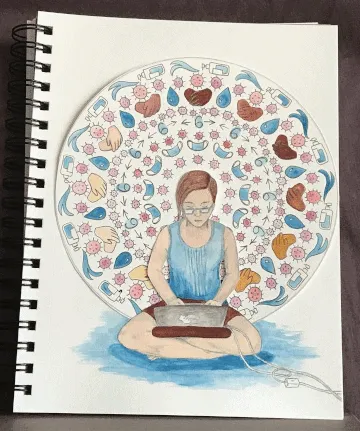Learning from Nicolette Johnson, a Ceramics/Visual Arts Teacher

Tell us about yourself and your art journey.
“I’ve taught visual arts and ceramics at New Hanover High for the past 8 years. I graduated from UNC-Greensboro with a BFA in Art Education and a concentration in design. I consider myself a designer that ‘solves problems’ using art. Being an art teacher is my dream job, and I often forget it’s a job because it keeps me on my toes.“
What do you have to offer other artists?
“I have some basic videos on a youtube channel: https://bit.ly/3j2AWY8 (‘The Art of Herding Cats’)
They’re mainly to support my students but there are some videos that could interest beginners in some fun activities. I upload at my own leisure and don’t usually read comments, so if you have questions it’s always best to email me directly.“
What is your favorite media and what media would you suggest that a beginning artist start with?
“I prefer to jump around from medium to medium. I use materials that suit what I’m working on and that I can afford.
For 2D work, I prefer graphite pencils or watercolor and think they’re both great for beginners. If you start with pencils, get a ‘B’ grade that can do darker than the normal ‘HB’. It will really help your drawing ‘pop’. Watercolors have a softer feel than acrylics, but also won’t ruin your paintbrushes if you forget to clean them thoroughly.
For 3D, I recommend basic cardboard for geometric shapes or wire and pliers for organic shapes. Clay is a great 3D medium, but it can get expensive quick with all the materials you need.“
What is your style of art to you prefer to create?
“I prefer any style that suits the problem at hand, but one I want learn more about is illustration. Combining words and art together interests me, but I’m lacking in the word department!“
Who are your favorite artists?
“I’m always trying to learn about new artists, so it changes often.
Right now, I’m learning about Nampevo, a potter from the Tewa Corn clan from the beginning of the twentieth century. I can’t handle clay myself right now because of a eczema flare up on my fingers, so at least admiring the designs has been refreshing.“
Nampeyo Showcase at the Arizona State Museum
Who is an artist or artists you’d love to be compared with?
“I feel it’s better to work with other artists than in competition with them.“
Where do you get inspiration?
“I either get inspiration from my students and their interests or in everyday problems that need to be fixed.
Technology has come a long way in offering inspiration, but it can also get overwhelming. It’s important to find a balance.“
Any suggestions for a productive & comfortable work space?
“A bright window on a sunny day makes for a great tracing table for basic outlines. I’ve always wanted a drafting table, but I don’t know where I would fit it in my tiny apartment.
A cleared off coffee table is my usual spot. Just make sure you know what is your coffee and what is your paint water!” Haha!
Do you use technology much? If so, what and how? Any recommendations of APPS, programs, etc.?
“I like making Gifs of my Art using free websites like https://gifmaker.me/.
Having a technology trick to bring it to life with movement while still having it feel hand-made appeals to me.“
(The watercolor self-portrait is an animated GIF, but unfortunately it doesn’t work on this blog. Click here to see it in action!)
What is the best art advice you’ve ever been been given?
“If you feel like you’re drawing yourself into a hole, take a break and take a step back. Fresh eyes make all the difference. You will always be your hardest critique. Have patience with yourself.“
What advice would you give a beginning artist?
“Don’t stress out if your art isn’t the same as someone you look up to. Either you just need more practice or you need to come to terms that you have your own style that’s valid as well.“
Any thoughts to share with Senior Adults about painting or creating art?
“Making Art is so important because it will keep you mentally and physically healthy.
You don’t need anything fancy or expensive to get started. Start small and just try to enjoy the process. If you can’t see details, just get a bigger brush and a bigger paper!“
How do you know when a work is finished?
“I always check in with others, usually my students, to see if something is finished. As long as they know how to speak constructively, anyone can offer decent advice to figure out if you’re finished.“
How is the best way to learn how to create art?
“Different ways will suit different people.
Taking a local class is a great way to meet people with similar interests.
Online classes can feel lonely. Kudos to anyone that’s figured out how to maintain that human touch through video chat.
The most important thing is to carve out time to make art, or you’ll never get around to it.
Taking a class or having a friend do it with you is more likely to make you stick to it than just trying it by yourself or only from a book.“
Anything else that you’d like to add?
“Everyone deserves to have the arts in their lives. We can take it for granted and think that they are luxury activities that are only for the talented, but that’s not true. You can really brighten someone else’s day with a quick sketch. We don’t need highly realistic art anymore, that’s what photos are for. Your contributions, no matter how small or rough, are an important way to share joy and other emotions with others.“
We appreciate so much Nicolette taking the time to share with us.
You can contact Nicolette at Nicolette.Johnson@nhcs.net